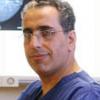Breast reconstruction surgery provides huge benefits for women who undergo mastectomy for breast cancer. This article explains the benefits of a new surgical technique called skin-sparing mastectomy.
Contents
- Introducing skin-sparing mastectomy
- Is it safe?
- Can the nipple be saved during mastectomy?
- Radiotherapy after skin-sparing mastectomy
- Conclusions
Introducing skin-sparing mastectomy
Both immediate and delayed breast reconstruction provide enormous benefits for women undergoing mastectomy for breast cancer. Skin-sparing mastectomy (SSM) has become a valid option for women who are undergoing mastectomy and immediate breast reconstruction for early breast cancer. The reason for this is that conventional non skin-sparing mastectomy (NSSM) often results in prominent scars on the new breast and a paddle of skin that is of a different colour and texture to the natural skin. With SSM most of the natural skin envelope is preserved during the immediate breast reconstruction leading to a much better aesthetic outcome. It also reduces the need for surgery on the other breast, which may otherwise be required to give a symmetrical appearance.
Is it safe?
Compared to NSSM the procedure of SSM seems to be safe for women undergoing mastectomy for invasive breast cancer smaller than 5cm in size and non-invasive breast cancer (known as DCIS), or risk reduction. However with more advanced cancers, there is probably less of a role for SSM due to the high probability of the need for post-mastectomy radiotherapy and the lack of medical data covering this.
Can the nipple be saved during mastectomy?
The nipple can be saved during skin-sparing mastectomy in selected cases. If the tumour is more than 2cm away from the nipple and the tissue behind the nipple is free from tumour then it is safe to save the nipple.
Radiotherapy after skin-sparing mastectomy
Most women undergoing mastectomy for breast cancer do not require radiotherapy following their surgery. However, patients with several positive regional lymph nodes and/or large tumours are offered radiotherapy in view of the proven reduction in recurrence and improved survival that it gives. The use of post-mastectomy radiotherapy has recently been on the increase and this has raised questions concerning both the effects of radiotherapy on a reconstructed breast and also the potential for the reconstructed breast to interfere with radiotherapy delivery. There are currently a lack of medical trials concerning the use of radiotherapy after SSM and immediate breast reconstruction and the published data that exist are based on very small numbers and vary quite considerably. It is accepted however, that radiotherapy following immediate breast reconstruction is associated with a higher rate of complications. The other concern regarding radiotherapy in the reconstructed breast is related to the use of implants. The scar tissue in particular often causes subsequent shrinkage of the reconstructed breast around the implant. One medical study compared 39 patients who received radiotherapy following implant and reconstruction, with 338 non-radiotherapy reconstructions and found that there was a significant negative impact on the reconstructive outcome with implants. The main complications were shrinkage and pain. Shrinkage results in poor appearance and sometimes requires further surgery. This has led some surgeons to recommend that immediate breast reconstruction be avoided if it is known that a patient is likely to require post-operative radiotherapy.
However, more recently, in an analysis that my colleagues carried out to evaluate unilateral postoperative chest wall radiotherapy in patients who had bilateral tissue expander/implant reconstruction, it was observed that in most patients although the shrinkage was higher on the irradiated side, overall symmetry, appearance and patient satisfaction remained high. In only 10% of the patients was shrinkage of the irradiated breast clinically significant. These observations are consistent with our experience, and support the notion that immediate breast reconstruction using tissue expansion and implants is an acceptable option for women undergoing mastectomy for breast cancer. Moreover, any clinically significant scarring around the implant known as capsule formation can be treated with surgery.
Despite the higher incidence of complications associated with post-mastectomy radiotherapy, most patients remain highly satisfied with immediate breast reconstruction. In addition, the adverse effects of radiotherapy on skin-sparing mastectomy and immediate breast reconstruction can be minimised by optimising radiotherapy delivery and by placing a saline filled tissue expander under the pectoral muscles in the chest in order to help delayed revision of reconstruction using an implant. This new concept, known as immediate-delayed reconstruction, can avoid the aesthetic and radiation delivery problems that can occur after immediate breast reconstruction.
We have recently conducted a study to evaluate the clinical outcome and patient’s satisfaction in approximately 100 women who had SSM and immediate reconstruction at The London Breast Institute. Our study confirmed the safety of this technique and showed a very high level of patient’s satisfaction (average score 9.5 out of 10). The complication rate was low and post-mastectomy radiotherapy did not compromise the high level of patient’s satisfaction.
Conclusions
The current evidence suggests that post-mastectomy radiotherapy is an acceptable option with skin-sparing mastectomy and immediate breast reconstruction in the multi-disciplinary setting. Although post-mastectomy radiotherapy is associated with a higher rate of complications, a satisfactory cosmetic outcome can be achieved in most patients. However, until better methods of radiotherapy delivery are developed to minimise complications, women at high risk of requiring post-mastectomy radiotherapy can be safely offered skin sparing mastectomy and immediate breast reconstruction using a saline-filled tissue expander and this can be replaced with a permanent prosthesis or converted into a flap reconstruction after the completion of the radiotherapy. Any scarring tissue formation around the implant can be surgically treated at this stage. This new concept, known as immediate-delayed reconstruction, can avoid the cosmetic and radiotherapy delivery problems that can occur after immediate breast reconstruction. Furthermore, prior radiotherapy does not represent a problem to skin-sparing mastectomy and immediate breast reconstruction, it does however increase the incidence of complications.



